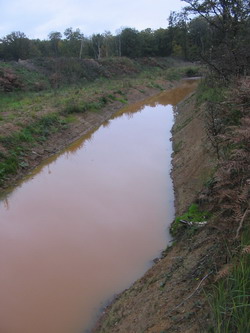Area evaporation model
The standard evaporation model proposed by Envmodels can be used to estimate VOC emissions to atmosphere due to liquid surfaces evaporation (open vessel containing liquid solvents, spill) exposed to natural wind effects.
In order to use this model, it is necessary to determine the compounds mass transfer coefficients. They are based on products diffusion coefficients (given by Envmodels products database). By default, products molecular masses can be considered (in this case calculation is a little overestimated).
A picture of a polluted spill is shown below:

Evaporation model is based on following assumptions:
- Evaporation model can be used as long as product is present all over evaporation surface (spill or exposed vessel),
- The standard practice is that the wind speed is the value at a height 10 meters above the surface. Thus, the model is acceptable for for liquids surface that are outdoors (the wind profile inside a building likely differs from the profile outside).
Example:
A Methyl Ethyl Ketone leak produces a 10 m2 outdoor spill. Liquid temperature is 25°C (298.15°K).
Elapsed time until the spill is confined (recovered with absorption products) is de 20 minutes. Wind speed measured over spill (at 10 meters high) is 6 m/s.
Calculated MEC emissions to atmosphere are 19.8 kg.
- Crowl, Daniel and Louvar, Joseph. 2002. Chemical Process Safety, Fundamentals with Applications. Second Edition.
- EIIP. 2007. Methods for Estimating Air Emissions from Chemical Manufacturing Facilities Chapter 16 in EIIP Volume II.
- EIIP. 2005. Methods for Estimating Air Emissions from Paint, Ink and Other Coating Manufacturing Facilities Chapter 8 in EIIP Volume II.



